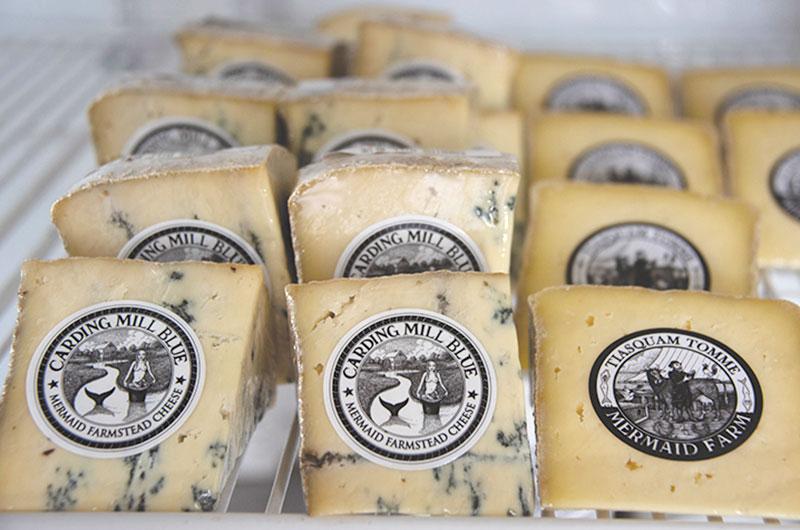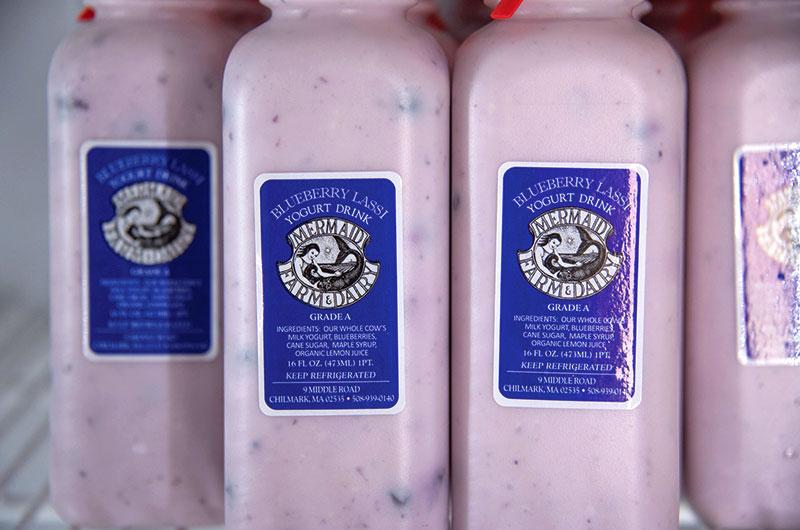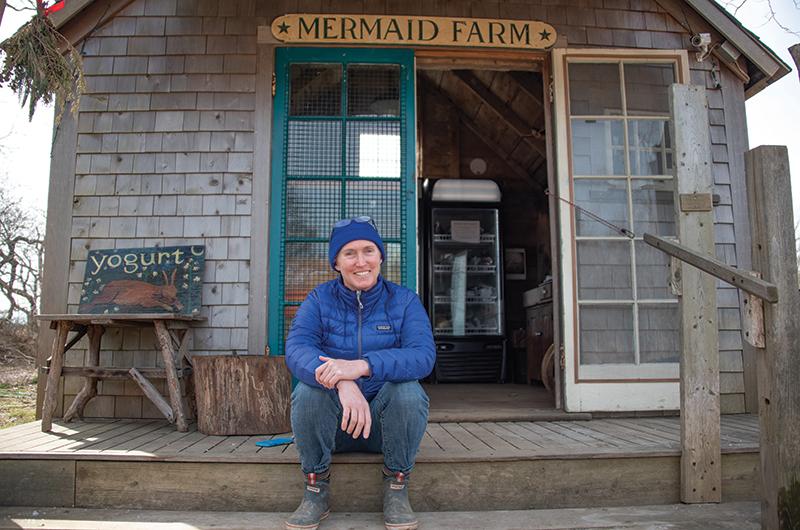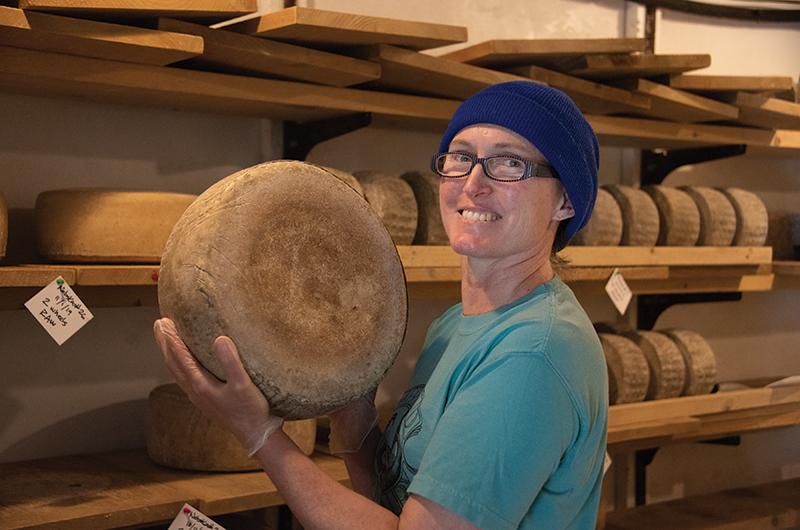My favorite farm stand is on Middle Road, right past the town line into Chilmark, and across from the oxen field. Look for the hand-painted signs signaling Mermaid Farm – “Raw Milk!” and perhaps “Slow Down, Catbird crossing.” On the covered porch of the small building you might find veggie starts or small blueberry bushes for sale. Inside, along with other offerings, you’ll see glass-fronted refrigerators with raw milk, yogurt, lassi drinks, an assortment of cheese and sometimes eggs. Zero in on the cheese shelf, for this is where the specialties are: Carding Mill Blue, Nobska, Tomme, King’s Highway, fromage and tubs of cow-milk feta. All of Mermaid Farm’s cheese is creamy and delicious, thanks to the “perfect” milk – from a small herd of Jersey and Normande cows.
“I think the cheese is good mainly because the milk is so good. Cheese is an expression of the land. If the land is healthy, then the grass is healthy, and the animals are healthy and the milk is healthy. The milk from Mermaid Farm is perfect – the perfect milk to be working with,” says Jessica Miller, the hardworking woman who turns the farm’s milk into yogurt, flavorful lassis and cheese.

This will be her fifth summer running the dairy production at Mermaid Farm. The small family farm, owned and operated by Caitlin Jones and Allen Healy, has been selling vegetables and dairy products for about 15 years. Jess was hired to produce yogurt and cheese, and what she likes about the job – which is physical, exhausting, detail-oriented and ever-changing – is the logistical puzzle of making the amount of milk available work for her production goals. She also loves producing a local food for our community to enjoy.
A West Tisbury native, Jess has worked hard at many jobs, including carpentry, working the counter at 7a Foods and at the beloved, no-longer operating Menemsha Café. She has worked as a caterer, and sold her own jellies and granola from a Board of Health-certified home kitchen. The procedures of food safety and sanitation are equally as important to her as the quality of the ingredients, the recipes, the packaging, the selling of food.

Jess was fortunate to be trained in dairy production and best practices by Michelle Tynann, the woman who she was replacing at Mermaid Farm. Although she knew nothing about making cheese or running a clean production room, Jess was excited about the opportunity to be involved in bringing local food to the community. She recalls that the last item on the job description was “must love scrubbing.” At the time, she laughed, but in fact it has proved to be true: scrubbing, rinsing and sanitizing the pile of “dishes,” the various stainless steel vats, rubber gaskets and hoses, working parts big and small, is the most time-consuming part of the job. Having established high standards for the small dairy production room, Jess loves to scrub until those standards are met, daily.
In addition to appreciating the delicious flavor of Mermaid Farm’s cream-rich milk, Jess recognizes that her own scientific curiosity lends itself to continual vigilance and improvement, both of production systems and the cheese itself.

There is a lot of attention to detail necessary in the cleaning process, in the way the machines are working, and with temperature regulation. She acknowledges that she keeps “ridiculously detailed” records of each cheese “make,” which allows her to go back and see what was done right, or could be improved upon. As she says, “A little OCD goes a long way in cheese-making.” To figure out how much milk she has for making cheese, Jess has to organize the week’s jigsaw puzzle of supply and demand. The first priority is to have enough raw milk for sales at the farm stand. In Massachusetts, raw milk can only be sold directly from the farm where it is produced, and Mermaid Farm has a loyal following of raw-milk customers.
The next priority is to produce enough yogurt to meet the demand at the stand, and at grocery stores and restaurants. Each week, Jess turns whatever amount of milk is left after the raw milk is bottled into a varying amount of yogurt, also a very popular item.
The dairy production room is tucked towards the back of the farm, down a farm lane marked with a sign to discourage visitors from exploring further. Past several greenhouses and a storage building is the dairy barn. Here the cows are milked, and next to the room where the milk is stored and cooled down, there is a small, clean room that can be washed down, ceiling to floor. Before entering, people put on rubber boots. A foot bath with bleach solution is set up by the door. The room is warm, sunny and smells of bleach and milk. It, and every piece of equipment in it, is cleaned constantly.
One machine in the room is a large “fridge” for yogurt that has a unique ability to stay at a steady warm temperature to incubate the yogurt culture for several hours, and then switch to a cooling temperature to set the yogurt. Yogurt is also used to mix up the yummy lassi drinks.
“We can never make enough lassis,” says Jess. “They are delicious, popular and profitable. Each year I’ve tried to increase productivity, and Allen has been very responsive to that.”

In the summer months, most of the milk produced goes to raw milk, yogurt and lassi drinks. Jess also tries to keep up with demand for feta and the herbed tubs of fromage. As demand for these drops in the fall, Jess can focus on filling the cave with cheeses that will be aged.
“The cave, when it is full of cheese, is a dairy piggy bank,” Jess says. It is a way to process milk in winter, and turn it into a product with longevity to sell during the summer.”
Jess loves all of the cheeses, but her favorite is probably the Carding Mill Blue. She enjoys the challenge of making it and its delicious flavor. The Tomme, a firm dry cheese with a slight grassy note, is a direct reflection of the farm’s milk, with only 1/16th of a teaspoon of culture added to 50 gallons of milk. The other bacteria in the raw milk interact with the culture to create the unique and mild flavor of the Tomme.
A big part of the puzzle production is having the cheese ready for buyers when flavor is at its peak, which varies from cheese to cheese. The Nobska is best when it is six months or older, while the blue is best at four months.
Jess enjoys selling the cheeses at the farmer’s market during the summer. “I love doing the market. Everyone at the farm thinks I’m insane,” she says with a laugh. Setting up the stand is a lot of work, and knowing how much to bring requires careful record keeping. But she loves interacting with customers.
When people taste the cheese, she says, “It awakens something in them. It is pretty special to be able to help people open up to the value of local food.

“For me, this is a dream job,” she says. “I love this land. To use the milk from this land, to create a product, feels very true and authentic to me.”
_____________________
Emily Meegan lives in Chilmark and works at the West Tisbury library.







